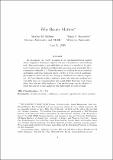| dc.contributor.author | Mobius, Markus | |
| dc.contributor.author | Rosenblat, Tanya | |
| dc.date.accessioned | 2009-06-08T14:12:26Z | |
| dc.date.issued | 2006 | |
| dc.identifier.citation | Mobius, Markus M. and Tanya S. Rosenblat. 2006. Why beauty matters. American Economic Review 96, no. 1: 222-235. | en |
| dc.identifier.issn | 0002-8282 | en |
| dc.identifier.uri | http://nrs.harvard.edu/urn-3:HUL.InstRepos:3043406 | |
| dc.description.abstract | We decompose the beauty premium in an experimental labor market where “employers” determine wages of “workers” who perform a maze-solving task. This task requires a true skill which we show to be unaffected by physical attractiveness. We find a sizable beauty premium and can identify three transmission channels: (a) physically attractive workers are more confident and higher confidence increases wages; (b) for a given level of confidence, physically attractive workers are (wrongly) considered more able by employers; (c) controlling for worker confidence, physically attractive workers have oral skills (such as communication and social skills) that raise their wages when they interact with employers. Our methodology can be adopted to study the sources of discriminatory pay differentials in other settings. | en |
| dc.description.sponsorship | Economics | en |
| dc.language.iso | en_US | en |
| dc.publisher | American Economic Association | en |
| dc.relation.isversionof | http://www.atypon-link.com/AEAP/doi/abs/10.1257/000282806776157515 | en |
| dc.relation.hasversion | http://mobius.fas.harvard.edu/Beauty/main.pdf | en |
| dash.license | LAA | |
| dc.subject | economic experiments | |
| dc.subject | labor markets | |
| dc.subject | beauty premium | |
| dc.subject | confidence | |
| dc.title | Why Beauty Matters | en |
| dc.relation.journal | American Economic Review | en |
| dash.depositing.author | Mobius, Markus | |
| dc.identifier.doi | 10.1257/000282806776157515 | * |
| dash.contributor.affiliated | Rosenblat, Tanya | |
| dash.contributor.affiliated | Mobius, Markus | |
| dc.identifier.orcid | 0000-0001-9840-4203 | |


